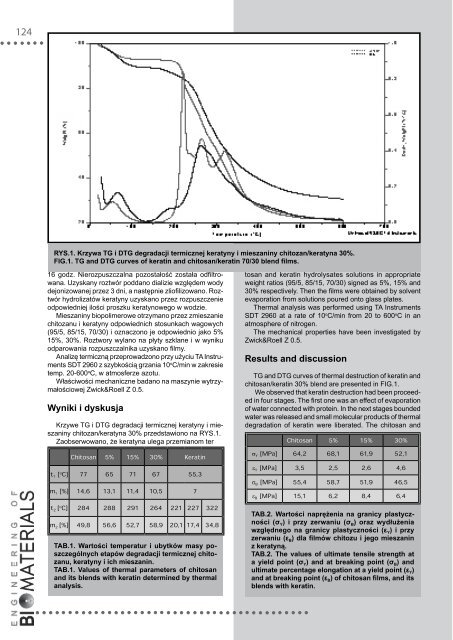89-91 - Polskie Stowarzyszenie Biomateriałów
89-91 - Polskie Stowarzyszenie Biomateriałów
89-91 - Polskie Stowarzyszenie Biomateriałów
You also want an ePaper? Increase the reach of your titles
YUMPU automatically turns print PDFs into web optimized ePapers that Google loves.
124<br />
rys.1. krzywa tg i dtg degradacji termicznej keratyny i mieszaniny chitozan/keratyna 30%.<br />
Fig.1. tg and dtg curves of keratin and chitosan/keratin 70/30 blend films.<br />
16 godz. Nierozpuszczalna pozostałość została odfiltrowana.<br />
uzyskany roztwór poddano dializie względem wody<br />
dejonizowanej przez 3 dni, a następnie zliofilizowano. roztwór<br />
hydrolizatów keratyny uzyskano przez rozpuszczenie<br />
odpowiedniej ilości proszku keratynowego w wodzie.<br />
Mieszaniny biopolimerowe otrzymano przez zmieszanie<br />
chitozanu i keratyny odpowiednich stosunkach wagowych<br />
(95/5, 85/15, 70/30) i oznaczono je odpowiednio jako 5%<br />
15%, 30%. roztwory wylano na płyty szklane i w wyniku<br />
odparowania rozpuszczalnika uzyskano filmy.<br />
Analizę termiczną przeprowadzono przy użyciu TA Instruments<br />
SDT 2960 z szybkością grzania 10 o C/min w zakresie<br />
temp. 20-600 o C, w atmosferze azotu.<br />
Właściwości mechaniczne badano na maszynie wytrzymałościowej<br />
Zwick&roell Z 0.5.<br />
wyniki i dyskusja<br />
Krzywe TG i DTG degradacji termicznej keratyny i mieszaniny<br />
chitozan/keratyna 30% przedstawiono na rYS.1.<br />
Zaobserwowano, że keratyna ulega przemianom ter<br />
Chitosan 5% 15% 30% Keratin<br />
t 1 [ o C] 77 65 71 67 55,3<br />
m 1 [%] 14,6 13,1 11,4 10,5 7<br />
t 2 [ o C] 284 288 2<strong>91</strong> 264 221 227 322<br />
m 2 [%] 49,8 56,6 52,7 58,9 20,1 17,4 34,8<br />
taB.1. wartości temperatur i ubytków masy poszczególnych<br />
etapów degradacji termicznej chitozanu,<br />
keratyny i ich mieszanin.<br />
taB.1. values of thermal parameters of chitosan<br />
and its blends with keratin determined by thermal<br />
analysis.<br />
tosan and keratin hydrolysates solutions in appropriate<br />
weight ratios (95/5, 85/15, 70/30) signed as 5%, 15% and<br />
30% respectively. Then the films were obtained by solvent<br />
evaporation from solutions poured onto glass plates.<br />
Thermal analysis was performed using TA Instruments<br />
SDT 2960 at a rate of 10 o C/min from 20 to 600 o C in an<br />
atmosphere of nitrogen.<br />
The mechanical properties have been investigated by<br />
Zwick&roell Z 0.5.<br />
results and discussion<br />
TG and DTG curves of thermal destruction of keratin and<br />
chitosan/keratin 30% blend are presented in FIG.1.<br />
We observed that keratin destruction had been proceeded<br />
in four stages. The first one was an effect of evaporation<br />
of water connected with protein. In the next stages bounded<br />
water was released and small molecular products of thermal<br />
degradation of keratin were liberated. The chitosan and<br />
Chitosan 5% 15% 30%<br />
σ Y [MPa] 64,2 68,1 61,9 52,1<br />
ε Y [MPa] 3,5 2,5 2,6 4,6<br />
σ B [MPa] 55,4 58,7 51,9 46,5<br />
ε B [MPa] 15,1 6,2 8,4 6,4<br />
taB.2. wartości naprężenia na granicy plastyczności<br />
(σ y) i przy zerwaniu (σ B) oraz wydłużenia<br />
względnego na granicy plastyczności (ε y) i przy<br />
zerwaniu (ε B) dla filmów chitozu i jego mieszanin<br />
z keratyną.<br />
taB.2. the values of ultimate tensile strength at<br />
a yield point (σ y) and at breaking point (σ B) and<br />
ultimate percentage elongation at a yield point (ε y)<br />
and at breaking point (ε B) of chitosan films, and its<br />
blends with keratin.













